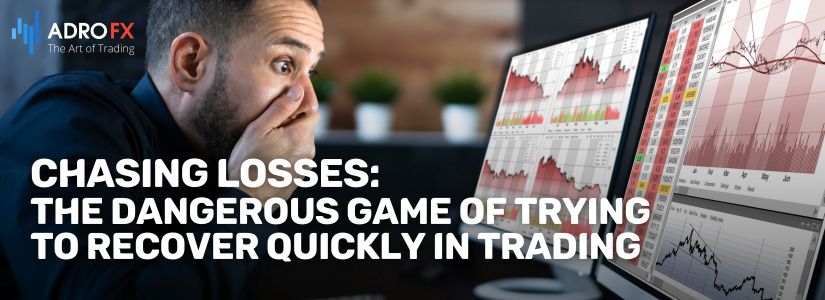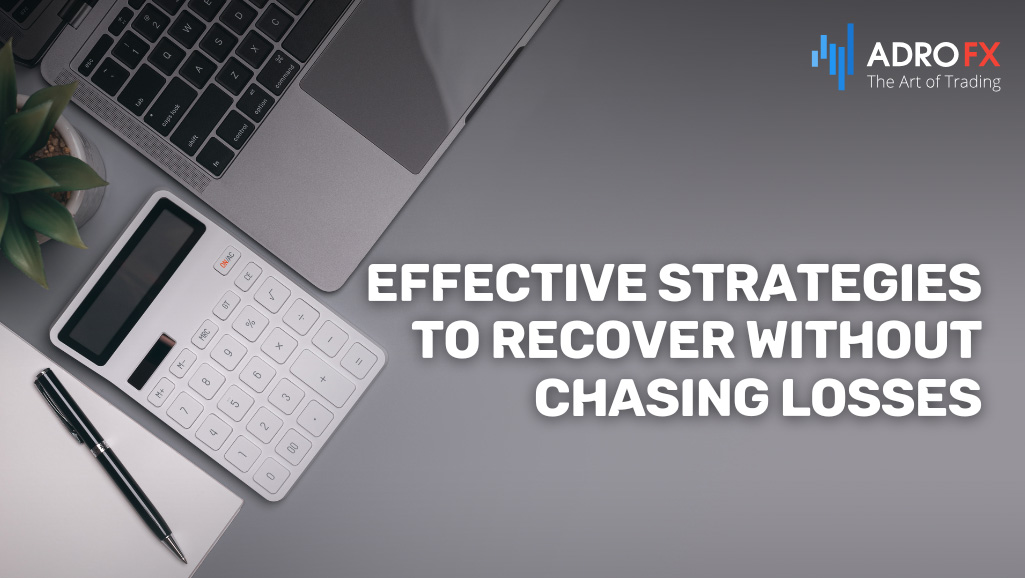Chasing Losses: The Dangerous Game of Trying to Recover Quickly in Trading

Have you ever found yourself desperately trying to win back what you’ve lost in a trade? It’s a scenario many traders know all too well. The adrenaline kicks in, and suddenly, the focus shifts from strategic decision-making to an almost reckless pursuit of breaking even. According to studies, nearly 80% of traders succumb to the temptation of chasing losses after a losing trade. This behavior, driven by the emotional reaction to loss, can quickly spiral into a dangerous cycle of bad decisions and mounting financial setbacks.
While chasing losses is a common mistake in trading, it often results in even bigger financial downfalls. The quicker a trader tries to recover without a clear plan, the greater the risk of further losses. This article will explore what it means to chase losses, the underlying psychology, and strategies to avoid this dangerous trap.
Understanding and Managing Chasing Losses in Trading
Chasing losses refers to the impulsive and emotional behavior where traders attempt to recover lost capital by making hasty trades after experiencing a loss. This behavior often arises from the desire to "win back" lost money quickly, leading traders to take on greater risks and make decisions driven by emotion rather than careful analysis. Although it may seem like a strategy to reverse a bad trade, chasing losses generally exacerbates the problem, as traders abandon their strategies and succumb to emotional reactions.
At its core, chasing losses is a psychological response to the pain of losing money. Loss aversion, a concept in behavioral finance, suggests that individuals experience the pain of a loss more intensely than the pleasure of a gain. When traders face a loss, they may struggle to accept it, leading to drastic actions in an attempt to recover quickly. This often involves increasing position sizes, trading impulsively, or deviating from established risk management practices, all of which heighten the risk of further losses.
Several psychological triggers contribute to the tendency to chase losses:
- Overconfidence
Success in trading can lead to overconfidence, where traders believe they have superior market prediction skills. When faced with a loss, they might view it as a minor setback and engage in riskier trades to recover.
When traders perceive an opportunity to quickly recoup losses, they may rush into trades without thorough analysis, driven by the fear of missing out on recovery chances. This fear often results in hasty decisions that can worsen the situation.
- Emotional Distress
Losses can create significant emotional turmoil, pushing traders to act impulsively. The urgency to recover quickly can override logical thinking, causing them to abandon well-established strategies and take irrational risks.
This occurs when traders, frustrated by a loss, attempt to "get even" with the market. Instead of reassessing their approach calmly, they let their emotions dictate their actions, treating trading as a battle rather than a strategic endeavor.
These emotional responses illustrate why chasing losses is particularly perilous. When trading under stress, decision-making capabilities are significantly diminished. Rather than adhering to a planned strategy, chasing losses often leads to a downward spiral of risky decisions and further financial damage. Recognizing when one is falling into the trap of chasing losses is crucial for maintaining discipline. Understanding the emotional drivers behind this behavior can help traders develop strategies to avoid it, such as setting strict Stop Losses or taking a break after significant losses to regain composure. Ultimately, seasoned traders acknowledge that losses are an inherent part of trading, and the best approach is to accept them calmly, adhere to a solid strategy, and resist the urge to act impulsively. This approach protects capital and maintains long-term trading discipline.

The Psychology Behind Chasing Losses
Fear and Greed
Fear and greed are dominant emotions in trading, influencing decision-making significantly. After a loss, the fear of further losses often clouds judgment, while the desire for quick recovery can lead to greed. This emotional response drives traders to make hasty decisions, abandoning their original strategies in favor of impulsive trades.
For instance, a trader who loses a substantial amount of capital may try to recover by increasing their position size, hoping for a swift reversal. This move, however, heightens their exposure to risk and is driven more by emotional need than rational analysis, often worsening the situation.
This cycle of fear and greed is highly dangerous, creating a feedback loop where losses prompt more aggressive, poorly calculated trades, leading to additional losses and perpetuating the cycle.
Cognitive Biases
Several cognitive biases exacerbate the problem of chasing losses. One significant bias is the sunk cost fallacy, where traders feel emotionally attached to a losing trade due to their previous investment of time and money. Instead of cutting their losses, they hold onto the position, hoping it will turn around despite clear signals indicating otherwise.
Another relevant bias is loss aversion, which indicates that people experience the pain of a loss more intensely than the pleasure of a gain. In trading, a $500 loss is felt more acutely than a $500 gain is felt rewarding. This heightened sensitivity to loss can lead traders to take extreme measures to avoid realizing a loss, even when closing a position would be the prudent course of action.
These cognitive biases, combined with emotional triggers like fear and greed, make it exceptionally challenging for traders to maintain rationality after a loss. Recognizing and understanding these psychological factors is essential for preserving trading discipline and avoiding the destructive urge to chase losses.
Also read: Addressing Trading Biases: Managing Psychological Factors in Day Trading
The Consequences of Chasing Losses
Financial Consequences
The financial damage caused by chasing losses can be severe. When a trader makes impulsive decisions to recover from a loss, they’re often risking even more capital than before, which leads to compounding losses. This can quickly spiral out of control. For instance, instead of cutting their losses after a 10% drawdown, a trader might continue to increase their position size, hoping to regain what’s lost. But if the market moves against them again, they could end up losing 20%, 30%, or even more of their capital.
In extreme cases, chasing losses can lead to margin calls, where the broker demands additional funds to cover the increased risk. If the trader can’t meet the margin call, they might be forced to liquidate their positions at a significant loss. Eventually, this pattern can result in an account blowout, where the trader loses all of their capital.
A real-world example of financial devastation is the case of Nick Leeson, a rogue trader whose attempts to recover losses led to the collapse of Barings Bank. Leeson took on increasingly risky positions in an effort to cover up previous losses, eventually bankrupting the bank in the process.
Emotional Consequences
The emotional toll of chasing losses can be equally damaging. Trading is stressful enough, but when you're constantly trying to recover from a series of bad trades, that stress can turn into frustration and burnout. Traders who chase losses often experience feelings of helplessness and anxiety, particularly if they see their account balance shrinking despite their efforts to recover. This emotional burden can lead to a downward spiral where poor mental health exacerbates poor trading performance, and vice versa.
For some traders, the stress of chasing losses becomes overwhelming, leading them to make rash, high-stakes decisions. In worst-case scenarios, this emotional exhaustion causes traders to quit trading altogether, unable to cope with the ongoing stress and frustration.
Also read: Stress in Day Trading: Strategies for Success and Well-Being
Why Chasing Losses is a Dangerous Game
Chasing losses may seem like a natural response after a series of losing trades, but it’s one of the most dangerous pitfalls for traders. The emotional pressure to recover quickly can push even the most experienced traders into taking risks they wouldn’t normally consider. This knee-jerk reaction often leads to impulsive decision-making, which rarely results in regaining lost capital. Instead, it can create a downward spiral of increasing losses and deteriorating mental well-being.
Market Volatility
Chasing losses in a volatile market is like trying to swim against a powerful current. Markets are inherently unpredictable, and attempting to recover quickly through emotional trades only amplifies this uncertainty. Whether you're trading forex, stocks, or commodities, market volatility can shift direction suddenly, making it difficult to regain lost capital in a short timeframe. When traders let their emotions guide their decisions instead of market analysis, they expose themselves to even greater risks. Rather than recovering, they often find themselves in deeper losses as the market reacts in unexpected ways.
Amplifying Losses
One of the most dangerous aspects of chasing losses is the potential for those losses to snowball. When traders make emotional decisions to recover capital quickly, they typically increase their risk exposure, which amplifies the potential for greater losses. For example, doubling down on a losing trade in the hope of a rebound can turn a 10% loss into a 50% or more loss if the market continues to move against the trader. This compounding effect not only wipes out trading accounts faster but also makes it exponentially more difficult to recover from the growing deficit.
Loss of Control
When traders chase losses, they essentially abandon their original trading strategy, letting emotions like fear and desperation take the wheel. This leads to impulsive decision-making, where trades are based on a desire to "make things right" instead of logical analysis. The result is a complete loss of control, with traders no longer following their risk management rules or relying on technical and fundamental analysis. This shift from strategy to emotion-driven trading makes it far more likely that a trader will continue to spiral into losses, further eroding their confidence and financial stability. Maintaining trading discipline is crucial to keeping control over trades, even in the face of setbacks.

Effective Strategies to Recover Without Chasing Losses
While it’s tempting to jump back into the market after a loss in hopes of quickly turning things around, it’s critical to approach recovery with a structured and disciplined plan. Effective recovery strategies require maintaining emotional control, sticking to sound trading principles, and understanding that bouncing back from losses takes time. By applying the right strategies, traders can protect themselves from the further emotional and financial damage that chasing losses often causes. Here are key approaches to consider when recovering from a setback.
Trading Discipline
One of the most critical aspects of trading recovery is maintaining discipline after a loss. Traders need to adhere to their initial trading plan, even when things don't go as expected. This means resisting the urge to chase losses and instead staying committed to pre-defined strategies. Setting realistic goals, such as limiting risk to a certain percentage per trade, is essential in preventing emotional decisions. By sticking to a plan, traders can minimize the psychological impact of losses and avoid the need for rushed recovery attempts.
Risk Management
Effective risk management is the cornerstone of trading discipline. Traders should use Stop Losses to automatically close a position if the market moves against them beyond a certain point, which helps protect capital. Setting appropriate risk levels is also crucial - most experienced traders recommend risking no more than 1-2% of their total account on any single trade. This keeps individual losses manageable and prevents them from snowballing into a larger issue. Additionally, traders should be mindful of over-leveraging, which can magnify both gains and losses. By using conservative leverage and setting risk parameters in advance, traders can minimize the financial impact of a loss.
Take a Break
After experiencing a loss, emotions run high. One of the most effective strategies to prevent emotional decision-making is to take a break from trading. Stepping away from the screens allows traders to regain composure and return with a fresh perspective. This pause can provide the mental clarity needed to assess the situation objectively and avoid chasing losses. Traders who regularly take breaks are better equipped to maintain trading discipline and avoid making further emotional mistakes.
Building Resilience: Long-Term Recovery Mindset
Recovering from trading losses isn’t just about regaining financial stability - it’s about building mental resilience. Traders who adopt a long-term recovery mindset are more likely to develop the patience and discipline required for consistent success. Rather than focusing on immediate recovery, it’s crucial to view setbacks as part of the journey and an opportunity to learn. By fostering resilience, traders can enhance their ability to handle future challenges while improving their overall approach to the markets.
Patience Over Speed
Recovering from a loss should never be a race. Patience is one of the most important traits for a successful trader. Trying to recover too quickly usually leads to emotional, high-risk trades that can compound losses. Instead, traders should focus on gradual recovery, slowly rebuilding their capital through disciplined, calculated trades. This long-term approach not only protects capital but also preserves mental well-being, allowing traders to avoid the frustration and stress that comes from chasing rapid gains. It’s important to remember that trading is a marathon, not a sprint, and recovering slowly and strategically is far more effective than trying to bounce back quickly.
Embrace Losses as Learning Opportunities
Instead of viewing losses as failures, traders should see them as opportunities for growth. Every loss provides valuable insights into mistakes that can be corrected in future trades. By analyzing what went wrong and applying that knowledge to future trades, traders can gradually improve their strategies and decision-making processes. This mindset shift - viewing losses as learning experiences - builds resilience and helps traders avoid emotional pitfalls. Over time, traders who learn from their losses develop the mental fortitude needed to weather market downturns and remain disciplined in their recovery efforts.
By embracing this long-term recovery mindset, traders can turn short-term setbacks into opportunities for personal and professional growth, making them more resilient and disciplined in their trading journey.
Also read: Crafting a Resilient Path to Trading Success: The Top Ten Money Habits Every Trader Should Embrace
Conclusion: Avoiding the Trap of Chasing Losses
Chasing losses is a perilous endeavor that often leads to a cycle of increasing financial and emotional turmoil. As we've explored, the dangers of chasing losses are multifaceted, ranging from escalating financial setbacks to the psychological strain of trading impulsively. This behavior undermines disciplined trading strategies and can swiftly lead to a deeper financial hole.
The benefits of a disciplined approach to trading recovery are significant. By adhering to a well-defined trading plan and practicing effective risk management, traders can mitigate the adverse effects of a loss and protect their capital. Taking the time to step away from the market after a setback allows for emotional recalibration and prevents further impulsive decisions.
To foster a more disciplined trading mindset, practice self-discipline and implement sound risk management techniques. Avoid the urge to chase losses by sticking to your trading plan and embracing setbacks as learning opportunities. For additional guidance, explore our resources on building trading discipline, such as demo accounts and educational materials available on our blog.
Practice self-discipline and focus on risk management to avoid the pitfalls of chasing losses. To enhance your trading discipline, consider exploring our related articles on building a robust trading strategy and managing your trading psychology. Check out our demo accounts and educational resources to help you stay on track and improve your trading skills.
About AdroFx
Established in 2018, AdroFx is known for its high technology and its ability to deliver high-quality brokerage services in more than 200 countries around the world. AdroFx makes every effort to keep its customers satisfied and to meet all the trading needs of any trader. With the five types of trading accounts, we have all it takes to fit any traders` needs and styles. The company provides access to 115+ trading instruments, including currencies, metals, stocks, and cryptocurrencies, which make it possible to make the most out of trading on the financial markets. Considering all the above, AdroFx is the perfect variant for anyone who doesn't settle for less than the best.










